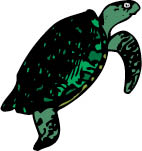


 Imagine an animal
that can get to be nine feet long, weigh more than
a ton, and has been around since before the time of the dinosaurs. This
creature lives in the ocean and has been found to dive 4,260 feet deep
subjecting the animal to a pressure of 265,000 pounds per square foot
or 1,900 pounds per square inch. It has taken science a long time to
figure out how this animal can avoid damage to its body and its lungs
from such pressures, and to figure out why the animal dives to such
incredible depths. The animal is the leatherback sea turtle, one of the
most incredibly designed creatures on the planet.
Imagine an animal
that can get to be nine feet long, weigh more than
a ton, and has been around since before the time of the dinosaurs. This
creature lives in the ocean and has been found to dive 4,260 feet deep
subjecting the animal to a pressure of 265,000 pounds per square foot
or 1,900 pounds per square inch. It has taken science a long time to
figure out how this animal can avoid damage to its body and its lungs
from such pressures, and to figure out why the animal dives to such
incredible depths. The animal is the leatherback sea turtle, one of the
most incredibly designed creatures on the planet.
Leatherback turtles live on a diet of jellyfish. The problem is that the jellyfish during the day dive to depths of 2,000 feet where they avoid most of their predators. Being at such depths not only provides the leatherbacks with their food, but the only enemies the leatherbacks have are sharks and killer whales and they do not go to such depths. The problem is that for an air-breathing animal, the pressures at such depths are prohibitive. Air trapped in tissues in the body including the lungs can rupture surrounding tissue. Nitrogen in the body causes decompression sickness or the bends when the animal returns to the surface. Highly technical equipment is required for humans to dive even a few hundred feet.
The leatherback is designed so that at about 115 feet down its lungs collapse driving the air out of its tissues. The animal gets its oxygen from stores in the blood and muscle rather than from the lungs. This also purges the nitrogen from its system so that when it returns to the surface there are no nitrogen bubbles in its blood stream and thus no problem with the bends. The turtle can stay underwater for hours and can travel very long distances, even if very slowly. The fact that the turtle can eat, swallow, and digest jellyfish under these conditions is amazing, and is still being studied by science. How oxygen can be efficiently moved from one source (the lungs) to another (blood and muscle) is still being studied. There are many possible applications for man in both man's attempts to use the sea efficiently and in industrial processes.
The intricacies of this complex ancient animal speak highly of engineering and design. It is difficult to conceive of mechanical chance processes that could produce all of the things necessary for the animal to survive in the environment that it is in. This shows another aspect of the statement in Romans 1:19-22 that we can know there is a God through the things that He has made.
--Source: National Wildlife, June/July 2006, page 30.
Back to Contents Does God Exist?, JanFeb07.